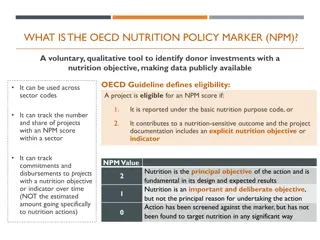Effective Partnership and Mutual Accountability in Nutrition Clusters
The content discusses the minimum commitments needed for participation in Nutrition Clusters, explains the Principles of Partnership, and explores how these principles can enhance coordination and accountability to affected populations. It emphasizes partner commitments, such as leadership, mainstreaming issues, and readiness to improve AAP. The Principles of Partnership focus on complementarity, transparency, results-oriented approaches, equality, and responsibility. An exercise involving explaining principles to a new member is also highlighted.
Download Presentation

Please find below an Image/Link to download the presentation.
The content on the website is provided AS IS for your information and personal use only. It may not be sold, licensed, or shared on other websites without obtaining consent from the author.If you encounter any issues during the download, it is possible that the publisher has removed the file from their server.
You are allowed to download the files provided on this website for personal or commercial use, subject to the condition that they are used lawfully. All files are the property of their respective owners.
The content on the website is provided AS IS for your information and personal use only. It may not be sold, licensed, or shared on other websites without obtaining consent from the author.
E N D
Presentation Transcript
1.5 Working Together Effectively: Principles of Partnership and Mutual Accountability
Objectives Summarize the minimum commitments for participation in the Nutrition Cluster Explain the origin and meaning of the Principles of Partnership. Describe how the Principles of Partnership can contribute to more effective coordination and enhanced accountability to affected populations.
Minimum Commitments for Participation As per the IASC Commitments for Participation in Clusters for Partners (in the Transformative Agenda) They should be regarded as an absolute minimum and a starting point They are not set in stone and should be adapted to each country s context
Partner Commitments Willingness to take on leadership (in WGs, sub- national level, etc.) Commitment to mainstream cross- cutting issues (age, gender, etc.) and protection Commitment to Humanitarian Principles and Principles of Partnership Readiness to participate in actions that specifically improve AAP A demonstrated understanding of the duties and responsibilities of membership as defined by IASC Capacity to contribute to Cluster s response planning Active participation Commitment to work cooperatively with other Cluster partners Ensure interpretation Undertake advocacy Committed to staff members 4
Principles of Partnership Complementarity: Build on comparative advantage Transparency: Communication Results-oriented: Coordinate capability & capacity Principles of Partnership Equality: Mutual respect Responsibility: Commit only what can be delivered
Exercise: Principles for Peter Peter is a new Nutrition Cluster member from a small international NGO 1. Spend 10 minutes preparing to meet Peter and explain the principle to him. Use simple language and don t use the name of the principle. Tell him what the principle means for him and his organization. 2. Your group member will do the role play with Peter and then others will guess which principle it is.
Key Messages: The Minimum Commitments help establish common criteria for participation in the cluster and apply to CLA as well! A commitment to Accountability to Affected People underline the commitments, and can be leveraged to build common approaches to AAP amongst partners The Principles of Partnership help define the ideal culture for cluster coordination. These same principles can apply to our relationships with vulnerable and affected communities. The partner commitments and principles should be reflected in the accountability framework for clusters























